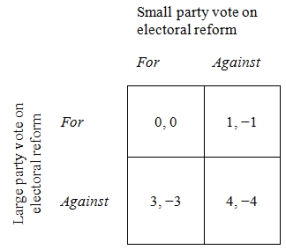Choosing Electoral Rules: A Game-Theoretic Approach
When would incumbent politicians be likely to abandon disproportional single-member district electoral laws in favor of a "fairer" proportional representation system (as occurred in New Zealand about a decade ago) ?
The following game can be used to explain the prospects for institutional reform in democracies. To keep things simple, we can think about the prospect for institutional reform (such as a change from single-member district plurality rule to proportional representation) as a game between a large party and a small party. They each must decide whether to vote for or against the proposed electoral reform. If the large party votes against reform, reform efforts fail and the next election is conducted under the existing rules.
Assume that voters prefer a more proportional electoral system. Thus, parties enjoy an electoral benefit if they vote for reform, but only if the other party votes against reform. Conversely, if a party votes against the reform, it pays a cost, but only if the other party votes for. Payoffs representing this electoral reform game are displayed in the following strategic-form game, where the large party's net electoral benefits from blocking reform are larger than the benefits the parties enjoy from being seen as lone reformers.
Figure 1. The Electoral Reform Game-Example 1

-What strategy combination(s) form(s) a Nash equilibrium in the above game? Hint: use the form (Large strategy; Small strategy) .
Definitions:
Amygdala
The amygdala is a region of the brain involved in emotional processes, including fear and pleasure responses.
Ethical Concern
A moral issue or problem that requires a person or organization to consider what is right and wrong in their conduct.
Milgram Studies
A series of social psychology experiments conducted by Stanley Milgram, which measured the willingness of study participants to obey an authority figure who instructed them to perform acts conflicting with their personal conscience.
Psychological Study
An academic and practical discipline involving the scientific investigation of mental functions and behaviors.
Q3: validity
Q8: Let's suppose that P<sub>1</sub> locates at Position
Q17: What's the difference between a preference ordering
Q17: What is the subgame perfect Nash equilibrium
Q18: According to some recent expert surveys, the
Q19: Which of the following is not an
Q24: What is (are) the key difference(s) between
Q25: Which of the following statements regarding rehabilitation
Q33: What is (are) the expected outcome (outcomes)
Q34: If you answered the previous question correctly,